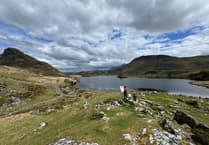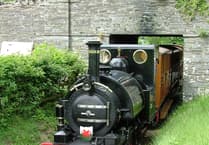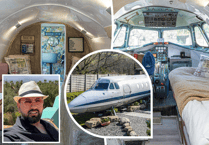During Remembrance Week, Colin Jones MBE of Capel Bangor continues recalling his time as a commander in the Gulf War...
TWENTY-FIVE years ago I was launched into battle, liberating Kuwait from the invasion of Iraq and the tyranny of Saddam Hussain. This week I hope to provide a brief insight into the realities of war.
After our first major contact with the enemy we formed up into platoon and company leaguers ready for our next set of QBOs (Quick Battle Orders).
The Platoon Commander sadly informed Corporal Satchell that his brother had been killed in action. Unfortunately, during C Company’s assault, they had a Blue on Blue incident, as a US, A-10 aircraft mistook a British Warrior armoured fighting vehicle for an enemy T54/55 tank and engaged, killing nine soldiers. It’s hard to imagine having to experience the tragic news of your brother’s death at any time, but in the height of battle it must have been unbearable.
Sleep was nonexistent and day rolled into night. The battle group continued its advance, winding through enemy obstacles and minefields, and defended positions until, on the Sunday, our advance was interrupted as the whole of the battle group paused for a memorial service in honour of our fallen.
During the service I was summoned back to my vehicle as reports of enemy activity had been identified to our front. I remember jumping into the turret and immediately observing two Soviet Gazza troop transporter vehicles full of Iraqi troops crossing past our position.
I ordered the gunner to engage with the 7.62mm chain gun. Unknown to me at the time, my gunner had stripped the chain gun down and was in the process of cleaning it.
“Switch to main armament,” I ordered, and we engaged with 30mm HE. Greenie, my gunner, quickly assembled the chain gun and, with a quick burst at the enemy, he halted them in their tracks and they soon surrendered.
Our next big engagement took place at night. At around 22.30 hours, the battle started in earnest.
Heavy British artillery bombardment poured down onto the enemy positions, lighting up the skies to our front.
Travelling at night with your turret traversed hard right and facing south, and your Warrior moving forward in an easterly direction, is difficult to control.
That night D Squadron confirmed destroying five T55 enemy tanks.
The objective was confirmed - to be clear of all enemy at about 05.00 hours on the morning of 27 February, 1991. On 28 February, 1991 the war was over.
The 4th Armoured Brigade had advanced 350 kilometres in 97 hours.
Fifty-four of those hours had been spent in contact against the enemy.
It had destroyed some 66 tanks, 90 armoured personnel carriers and 37 Artillery pieces, over 5,000 enemy officers and men were captured.
After Iraq accepted every condition of the UN ceasefire on 3 March, 1991, the Battle group moved eastward across the Wadi Al Batin, deep into Kuwait.
We would remain there for nearly a month.
The battle group mounted an array of patrolling operations in support of the engineers who had been tasked to clear and destroy enemy equipment, weapons and armour.
On 7 March, A Company was tasked to assist the RAF crash investigators in search of the Tornado aircraft which had been lost during the air war. This was to be a two-day mission.
The company was loaded onto two Chinook helicopters and escorted by three Army Air Corps Lynx helicopters.
We flew deep into Iraq and, becoming the most northerly of any Army unit during the campaign, the company was tasked to provide an outer cordon, which is a ring of steel around the crash sights so the investigators could examine the downed aircraft and extract the black boxes which provide all the aircraft data. News from Brigade Headquarters confirmed that the 3 RRF Battle group would be last to withdraw and return home and we would continue with the clearance operation of Kuwait.
During our final week in the Kuwaiti desert, the battle group received a lot of high powered visitors.
I remember one such visit was from General Norman Schwarzkopf, Commander-in-Chief Coalition forces in the Persian Gulf.
As he addressed the battle group he asked if there was any members of the press present, and once he was assured there wasn’t he indicated that the advance should have continued all the way to Baghdad and I remember his words. “Mark my words men, the job has not been completed and within the next decade we will have to return to complete the task.”
No truer words were spoken as I returned to Iraq in 2004 as a Captain with the 1st Battalion The Royal Welch Fusiliers battle group.
Next, the battle group was tasked to transform the old derelict abandoned Kuwaiti government building and establish the new British Forces HQ, named St George’s Lines and then prepare all vehicles and equipment ready to handover to the 2nd Battalion The Royal Anglian Regiment. Handover complete, we departed Kuwait and headed south, back to Al Jubayl in Saudi Arabia.
We would spend approximately a week in Jubail and then, the day finally arrived, and we returned to Germany. I was reunited with Dorothy and Shaun.
I am a very proud Royal Welch man and as a frontline soldier with over 30 years service I have served with some very brave and courageous men. It was an honour and a privilege to fix bayonets with the men who fought to liberate Kuwait from the 3rd Battalion The Royal Regiment of Fusiliers (3 RRF) during the first Gulf War.
I experienced a mix of emotions on my return from Iraq.
Relief and excitement of going home to loved ones, and the hope that you have made a difference. There is also the enormous weight of guilt from the fact that not all the men that you have fought with will be returning home. The main reason that, after 25 years, I decided to put pen to paper was in memory of the 10 brave men, nine from Call signs 22 & 23, C Company 3RRF and Fusilier Alexander Bunney, 2 Platoon, A Company 3RRF, who made the ultimate sacrifice in 1991.
I witnessed an act of respect and poignancy, made by Sergeant Willie Brown in the aftermath of the death of Fusilier Bunny. The memory remains with me today as he placed his hackle (which is the plum worn in the headdress of Fusiliers) into the body bag with Fusilier Bunney as the helicopter landed to recover his body.




.jpeg?width=209&height=140&crop=209:145,smart&quality=75)
Comments
This article has no comments yet. Be the first to leave a comment.